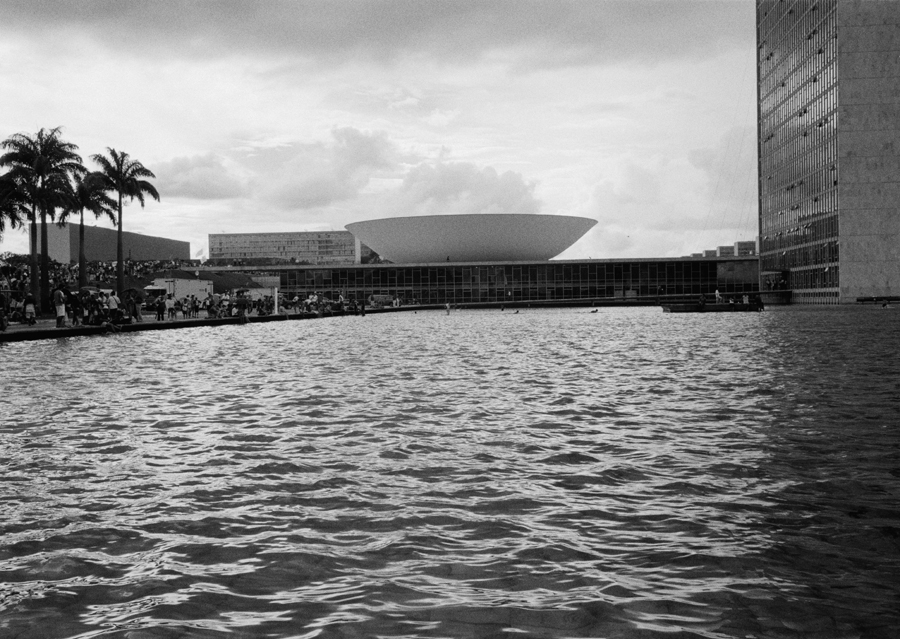Condemned To Be Modern
Los Angeles Municipal Art Gallery, Los Angeles, USA
Los Angeles Municipal Art Gallery, Los Angeles, USA

Frank Lloyd Wright was no stranger to difficult clients, but in 1919 he may have met his match. Aline Barnsdall, an oil heiress, feminist and political activist, hired the architect to build her a home and ‘progressive theatrical community’ on a rocky acropolis overlooking Hollywood. Designed in the Mayan-revival style, with pitched walls, bas-reliefs, ornate spires and a moat, the Hollyhock House project was largely overseen by Wright’s assistant, Rudolph Schindler, who lent his boss’ exotic kitsch a restrained modernist touch. Furious with its costly impracticalities, Barnsdall fired Wright and donated the building to the City of Los Angeles, which left it empty for decades. The site thus makes a perfect location for ‘Condemned to Be Modern’, an exhibition of work by Latin American artists negotiating the conflicted legacy of modernism, curated by Clara Kim as part of the Pacific Standard Time: LA/LA biennial.

On opening day, I found myself standing before Hollyhock, with my back to the city’s sprawl, as I watched performer Crystal Sepúlveda crouch atop a short parapet on the house’s exterior in a leopard-print cat-suit, like some ancient feline goddess, in Clarissa Tossin’s half-hour performance, Ch’u Mayaa (Maya Blue, 2017). It was a powerful evocation of the culture Wright plundered for his design – one shared by many of the Central American immigrants living within view of Barnsdall’s gilded perch. In slow, tense movements, Sepúlveda transformed into a Mayan frieze, before flinging herself down the porch steps, landing like a body dispelled and broken by architecture indifferent to human need.
Just across a courtyard, inside the Los Angeles Municipal Art Gallery – a squat, concrete structure built in the 1970s – a film documenting Tossin’s performance joins works by 21 artists from Brazil, Cuba and Mexico. At the gallery’s entrance, the delicate, gilded strands of Leonor Antunes’s Discrepancies with M.G. (2011–17) hang silhouetted against Lucia Koch’s The Doors (2017), a film transparency affixed to a sweeping window with the vibrant chroma of a purple sunset. The forms of Antunes’s sculpture reference the iconic Mathias Goeritz design of the Museo Experimental El Eco, Mexico City, though reduced to near-weightlessness. Here modernism has become evanescent, its traces fading with the setting sun.
History is not always so easy to forget, though. The exhibition draws its title from a wry remark that art critic Mário Pedrosa made about Brazilians in the 1950s, as they prepared the move to their new, Oscar Niemeyer-designed capitol in the Amazon. Brasilia is a notorious modernist failure; as if designed by airplane, its vast and isolated grid starves street life and constricts car traffic. Tossin is from Brasilia, and has previously focused her lens on the wasteful maintenance its government palaces require (White Marble Everyday, 2009). Mauro Restiffe’s photographs Empossamento #2–9 (Inauguration, 2003), meanwhile, capture the city’s broad esplanades overflowing with attendees to the inauguration of former President Luiz Inácio Lula da Silva: people spill over railings and trash the lawns, mucking up Niemeyer’s pristine picture. These hang near Lais Myrrha’s Gameleira 1971 Project (2014), in which Niemeyer himself is lanced: a table of posters and ephemera documents a 1971 disaster in Belo Horizonte that saw 10,000 tons of concrete from a pavilion he designed crush more than 100 workers. If such celebrated structures threaten human life, perhaps we should leave them to the wild: Renata Lucas’s bracing 5-channel video-installation Barulho de fundo (Background noise, 2005–09) tracks the movements of iguanas, monkeys, parrots and a jaguar as they stalk the emptied halls of Niemeyer’s Ciccillo Matarazzo Pavilion, the São Paulo Biennial’s home in Ibirapuera Park – an irreverent send-up of modernism’s role in the construction of Brazilian national mythology.

Much of this work is heavy-handed, not unlike its object of criticism. In Jonathas de Andrade’s Tropical Hangover (2009), though, modernist architecture is simply a backdrop for the life of a portero, or doorman, in 1970s Recife. Pages of the anonymous man’s diary, which De Andrade fished from a rubbish heap, span four gallery walls alongside contemporaneous photographs of the cityscape and its people; in them he writes of weather and work, though mostly of sexual escapades. The remarkably voyeuristic project imparts a sense of homoerotic intimacy between two strangers, artist and subject – a relationship spanning three decades but rooted in the mouldering landscape of Recife, their common home. De Andrade focuses a laser eye on the individual subject overlooked by modernism’s aerial views.
‘What is so sinister about modernism?’ filmmaker Thom Anderson asks in his documentary Los Angeles Plays Itself (2003), noting that Hollyhock’s neighbouring twin, the Ennis House, became a favourite filming location for haunted castles and villains’ lairs. Barnsdall’s utopian commune was never completed, not unlike the project of modernist architecture – born from radical politics, now emptied of everything but style.
Main image: Clarissa Tossin, Maya Blue, 2017, performance documentation, featuring Crystal Sepúlveda. Courtesy: the artist

























